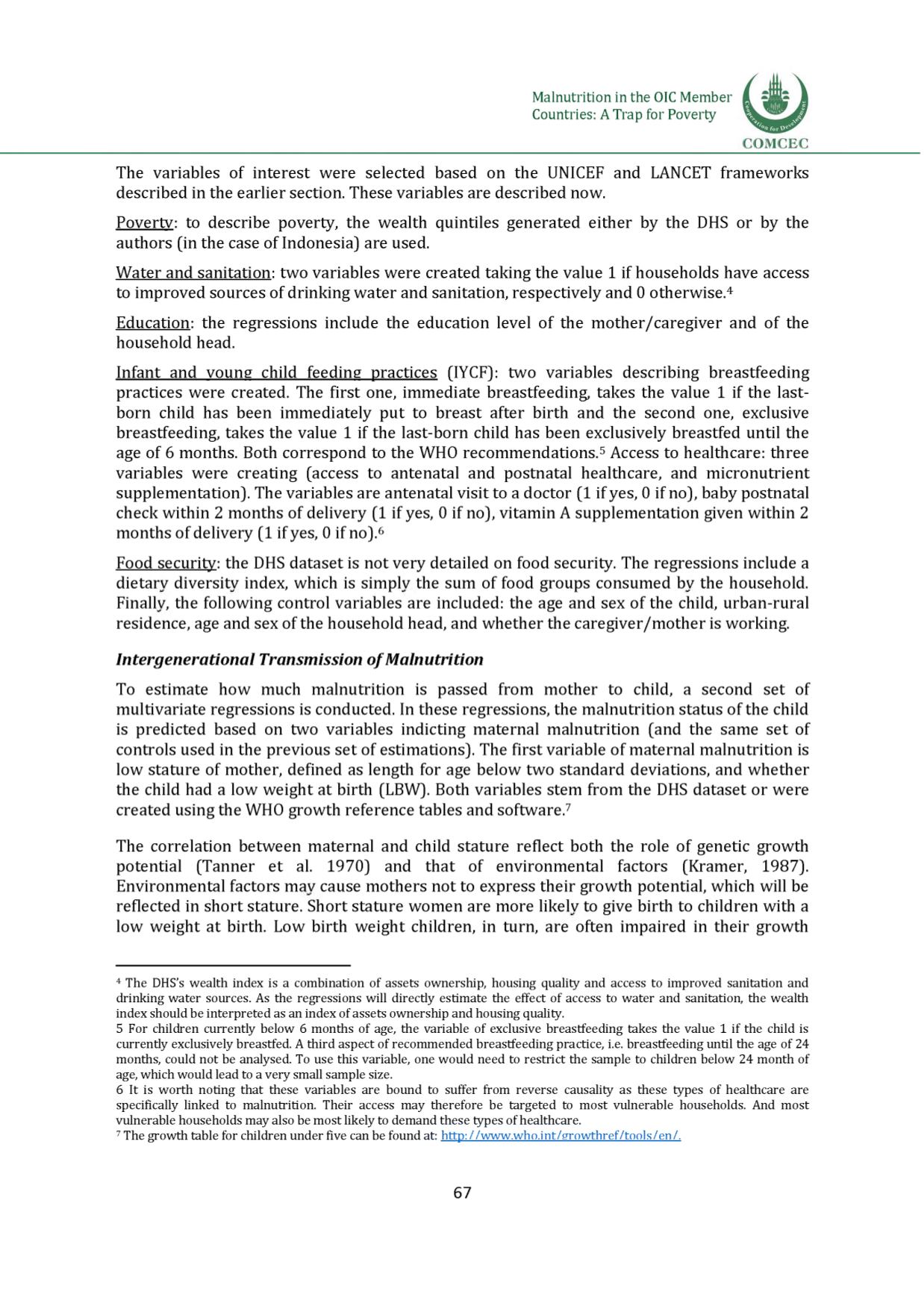

Malnutrition in the OIC Member
Countries: A Trap for Poverty
The variables of interest were selected based on the UNICEF and LANCET frameworks
described in the earlier section. These variables are described now.
Poverty: to describe poverty, the wealth quintiles generated either by the DHS or by the
authors (in the case of Indonesia] are used.
Water and sanitation: two variables were created taking the value 1 if households have access
to improved sources of drinking water and sanitation, respectively and
0
otherwise
.4
Education: the regressions include the education level of the mother/caregiver and of the
household head.
Infant and young child feeding practices (IYCF): two variables describing breastfeeding
practices were created. The first one, immediate breastfeeding, takes the value 1 if the last
born child has been immediately put to breast after birth and the second one, exclusive
breastfeeding, takes the value
1
if the last-born child has been exclusively breastfed until the
age of
6
months. Both correspond to the WHO recommendations
.5
Access to healthcare: three
variables were creating (access to antenatal and postnatal healthcare, and micronutrient
supplementation]. The variables are antenatal visit to a doctor (1 if yes, 0 if no], baby postnatal
check within 2 months of delivery (1 if yes, 0 if no], vitamin A supplementation given within 2
months of delivery
(1
if yes,
0
if no
]. 6
Food security: the DHS dataset is not very detailed on food security. The regressions include a
dietary diversity index, which is simply the sum of food groups consumed by the household.
Finally, the following control variables are included: the age and sex of the child, urban-rural
residence, age and sex of the household head, and whether the caregiver/mother is working.
Intergenerational Transmission ofMalnutrition
To estimate how much malnutrition is passed from mother to child, a second set of
multivariate regressions is conducted. In these regressions, the malnutrition status of the child
is predicted based on two variables indicting maternal malnutrition (and the same set of
controls used in the previous set of estimations]. The first variable of maternal malnutrition is
low stature of mother, defined as length for age below two standard deviations, and whether
the child had a low weight at birth (LBW]. Both variables stem from the DHS dataset or were
created using the WHO growth reference tables and software
.7
The correlation between maternal and child stature reflect both the role of genetic growth
potential (Tanner et al. 1970] and that of environmental factors (Kramer, 1987].
Environmental factors may cause mothers not to express their growth potential, which will be
reflected in short stature. Short stature women are more likely to give birth to children with a
low weight at birth. Low birth weight children, in turn, are often impaired in their growth
4 The DHS's wealth index is a combination of assets ownership, housing quality and access to improved sanitation and
drinking water sources. As the regressions will directly estimate the effect of access to water and sanitation, the wealth
index should be interpreted as an index of assets ownership and housing quality.
5 For children currently below 6 months of age, the variable of exclusive breastfeeding takes the value 1 if the child is
currently exclusively breastfed. A third aspect of recommended breastfeeding practice, i.e. breastfeeding until the age of 24
months, could not be analysed. To use this variable, one would need to restrict the sample to children below 24 month of
age, which would lead to a very small sample size.
6 It is worth noting that these variables are bound to suffer from reverse causality as these types of healthcare are
specifically linked to malnutrition. Their access may therefore be targeted to most vulnerable households. And most
vulnerable households may also be most likely to demand these types of healthcare.
7The growth table for children under five can be found at
: http://www.who.int/growthrRf/tools/Rn/.67
















